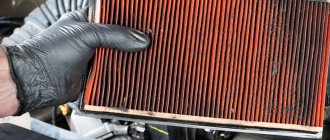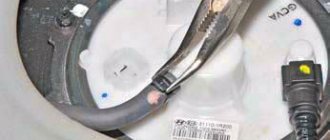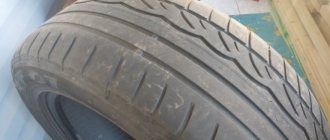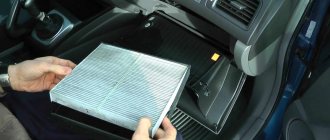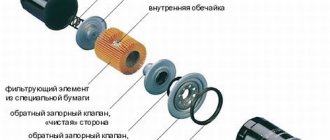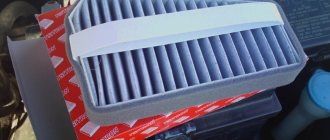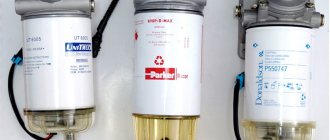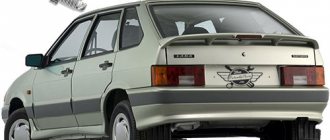Any modern vehicle is equipped with parts that require periodic replacement. The fuel filter is considered one of these elements. It is the most important part of the fuel system. Manufacturers always indicate its service life, but it rarely corresponds to reality. Poor road conditions and low-quality fuel negatively affect the performance properties of the filter. Let's figure out how often you need to change the fuel filter, what malfunctions occur and how to avoid them.
Fuel filtration
Over the entire period of operation, the vehicle consumes an infinite amount of fuel. Accordingly, it clogs the power system and does it quickly, which is why filters are installed on all brands of cars. Filtration requirements are higher for diesel engines due to high injection pressure.
Filtration is a two-step process. First, gasoline is filtered through a mesh and then through a fine filter. Previously, the part was installed under the bottom, but today the placement method has changed. The filter is now in the fuel module. On the one hand, this is a convenient location, but on the other, it’s not. When replacing, it is necessary to resort to complete disassembly of the entire module.
As for diesel filters, they are installed separately from the fuel tank. Compared to gasoline ones, they require water sensors and a drain plug.
Diesel engines
Replacing the fuel filter on a diesel engine is a big separate story. It is represented here by several components. Thus, a distinction is made between a coarse filter, a fine filter, and a special separator. All these components of one large cleaning complex have different functions, but can be placed in a single housing.
The function of coarse filters is to clean diesel fuel from fairly large impurities. And what’s interesting is that you won’t find these in the fuel system of passenger cars, but they are found in trucks and various agricultural vehicles.
Separator filters are used to purify fuel from water. This element is somewhat reminiscent of a sump. Here the diesel is sent up and the water collects at the bottom and then goes out through the drain.
Fine cleaning parts are used for maximum cleaning of solarium from the smallest fraction. In most cases, it is this element that gets clogged.
Car enthusiasts claim that replacing the fuel filter on a diesel engine is carried out much more often than on similar gasoline cars. And there is also an opinion that replacements are necessary in winter.
What happens if the filter is clogged?
Dirt from fuel clogs filters and renders them inoperable. There is no need to blame oil refineries. Fuel becomes contaminated during pumping.
As soon as a blockage occurs, the driver immediately understands it. During rapid acceleration and driving at high speed, you feel the unstable behavior of your car. First, the thrust decreases, then the engine begins to function intermittently. By the way, in quiet mode and at idle, everything functions as before, without changes. Drivers are wondering when to change the fuel filter in this case.
Here are the symptoms indicating a clogged filter:
Poor performance of the power unit and a sharp decrease in power. A heavily clogged filter is no longer able to clean the incoming fuel. The engine does not receive the required amount of gasoline, normal functioning is out of the question.
Spark plugs, λ-probe with accelerators begin to wear out faster. Unrefined fuel does not burn out completely, and some of it settles on the spark plugs and pistons. Next, the “contaminated” mixture passes through the accelerators and the probe, thereby reducing their resource and service life.
Fuel consumption increases not because of a clogged filter. It “takes away” engine power, forcing the driver to press harder on the gas to accelerate the car. Accordingly, this requires even more gasoline.
The engine does not start. One fine day the engine will simply stop starting. This happens at a time when the filter is so dirty that it can no longer cope with its “responsibilities”. The only way out is to finally replace it with a new one.
There are situations in the life of car owners when the power unit begins to trip. Usually few people pay attention to this symptom. As a result, the engine stalls, and the reason for this is a clogged fuel filter.
When to change the fuel filter
How to dispose of waste
As mentioned in one of our articles about changing car oil, changing it is not that difficult and quite quick. But after any replacement of an automobile fluid, what remains is an old, used mixture of contaminated engine oil, transmission oil or hydraulic fluid that has lost its properties. Therefore, in this article we will try to figure out what to do with the leftovers and how to properly dispose of them. (adsbygoogle = window.adsbygoogle || []).push({}); Naturally, this question may be of interest only to those car owners who independently change all the technical fluids in their car. Because all service stations keep the waste for themselves and deal with the disposal issue themselves. But in another case, you will be left with a whole canister with several liters of unnecessary liquid, and what to do with it will become clear after reading this article. Is it possible to pour out the waste? We’ll answer right away - absolutely not! Without even looking at the legislation, which prohibits pouring liquids of this kind into the environment. Car oil is a very toxic material that can poison all living things, including plants, various insects, water and some animals; it also takes a very long time to decompose, like any petroleum product. (adsbygoogle = window.adsbygoogle || []).push({}); Therefore, there is no need to destroy the place where we all live. It is worth noting that according to European legislation, a fine of several thousand rubles is provided for such actions. But unfortunately, in Russia, all the severity of the laws is compensated by the optionality of their implementation. Which leads to adverse consequences due to irresponsible citizens. How to dispose of used oil? Theoretically, every car owner has the opportunity to hand over waste to a special company that deals with the disposal of waste of this kind. But this is unlikely, and it sounds good only in words. (function(w, d, n, s, t) { w[n] = w[n] || []; w[n].push(function() { Ya.Context.AdvManager.render({ blockId: "RA-149162-8", renderTo: "yandex_rtb_R-A-149162-8", horizontalAlign: false, async: true }); }); t = d.getElementsByTagName("script")[0]; s = d .createElement("script"); s.type = "text/javascript"; s.src = "//an.yandex.ru/system/context.js"; s.async = true; t.parentNode.insertBefore( s, t); })(this, this.document, "yandexContextAsyncCallbacks"); The fact is that this type of activity on the territory of the Russian Federation is very poorly developed. Therefore, such a company may not be near you. But you will also have to transport the waste yourself and, on top of that, pay for disposal. Which for a Russian person looks wild. It is worth noting that even the most conscientious citizen will probably not be able to use the services of such companies. Since they most likely work only with large clients and with large volumes. Therefore, this method is absolutely not suitable in the realities of our time. How to sell used oil? I think none of the readers will be surprised to learn that used oil also costs money. And there are many private owners and companies buying old automobile oil. Yes, the cost of mining when purchased is small, but still, this is an additional plus for problem-free disposal, and even the money will be paid to you personally. In this case, the situation is approximately the same as when buying batteries that have expired. A private owner like you is buying used oil at the lowest price possible. When a certain volume has been accumulated, it is sold in bulk to a large company at a price significantly higher than the purchase price. yandex_stat_id = 3; yandex_partner_id = 149162; yandex_site_bg_color = 'ffffff'; yandex_ad_format = 'direct'; yandex_font_size = 1.0; yandex_direct_type = 'vertical'; yandex_direct_border_type = 'ad'; yandex_direct_limit = 1; yandex_direct_title_font_size = 2; yandex_direct_links_underline = true; yandex_direct_bg_color = 'ffffff'; yandex_direct_border_color = 'ffffff'; yandex_direct_title_color = '0C77EC'; yandex_direct_url_color = '000000'; yandex_direct_text_color = '000000'; yandex_direct_hover_color = 'CC0000'; yandex_direct_favicon = true; yandex_no_sitelinks = true; document.write("); Now it becomes clear why many technical inspection stations and car oil change shops keep their used oil. After all, when a large volume of old technical fluid accumulates, you can gain additional money. Don’t despair, if you can’t find mining buyers in your city, then most likely they can be easily found through the private classifieds website - avito.ru. Used oil in everyday life In addition to recycling waste oil, it can be used in everyday life for many things. First of all, mining is used as an excellent liquid lubricant. Although it has expired and is no longer suitable for use in an internal combustion engine, it can be used with great success to lubricate locks, hinges, bicycles or other mechanisms and devices. Also, waste oil is often used as fuel for homemade stoves used to heat garages or service stations. Like any petroleum product, old automobile oil tends to burn well, and the combustion temperature is very high. Therefore, it is ideal as a material for special waste oil furnaces, which can be made with your own hands using numerous drawings on the Internet. yandex_stat_id = 3; yandex_partner_id = 149162; yandex_site_bg_color = 'ffffff'; yandex_ad_format = 'direct'; yandex_font_size = 1.0; yandex_direct_type = 'vertical'; yandex_direct_border_type = 'ad'; yandex_direct_limit = 1; yandex_direct_title_font_size = 2; yandex_direct_links_underline = true; yandex_direct_bg_color = 'ffffff'; yandex_direct_border_color = 'ffffff'; yandex_direct_title_color = '0C77EC'; yandex_direct_url_color = '000000'; yandex_direct_text_color = '000000'; yandex_direct_hover_color = 'CC0000'; yandex_direct_favicon = true; yandex_no_sitelinks = true; document.write("); Another way to use mining is for anti-corrosion treatment of various metal objects. In Soviet times. When there was a shortage of specialized products to combat corrosion, used oil successfully coped with a non-core task. This application became possible due to numerous additives that have good moisture repellent properties. Of course, today there are many specialized tools that cope with this problem more effectively and longer. But as the cheapest alternative, especially for use in the garden or dacha, used oil is ideal. These same moisture-repellent properties are successfully used by business people for processing wooden structures. The fact is that wood impregnated in waste oil does not rot for many years. Recycling used oil The scheme is very similar to the recycling and disposal of car batteries. As a result, after several stages of repurchase, the used oil is returned to the manufacturer. Where recycling takes place, with multiple outcomes in mind. 1. Used oil, through chemical reactions, decomposes into some basic components, which are then used in the production of new oil. Naturally, components produced in this way are much cheaper than those manufactured from the very beginning. This fact also affects the final cost of the product and allows the company to reduce the cost of its products. 2. In some cases, the oil manufacturer purchases waste fluid sorted by composition. In other words, if a large volume of waste is obtained from a single type of oil from the same manufacturer, then it goes for cleaning and refining. This oil undergoes several stages of cleaning, the addition of special additives, and is re-produced, but this time intended for equipment that does not require high performance characteristics from the oil. 3. Also, today new compositions of automobile oil are being actively developed. Allowing the full reuse of technical fluid after a simple cleaning procedure. As leading scientists say, it is incredibly difficult to make such a composition, but it is possible. Therefore, we can soon expect the appearance of refillable automobile oil. Author of the article: Dmitry Gotovchik, 2017View news
Filter replacement frequency
The technical documents of any vehicle always contain information about how many kilometers to change the fuel filter. Typically, this period coincides in all respects with the time of the technical inspection. Thus, the replacement frequency varies from 15 to 40 thousand km.
Many European and Western manufacturers do not indicate the replacement period for filters at all. In Europe, the service life of a car is 5 years. It turns out that the filter elements should work the same amount.
Roads in post-Soviet countries leave much to be desired. Automotive parts wear out twice as fast, which means you will have to change filters more often. You can calculate the interval yourself. To do this, you need to take the mileage amount indicated by the manufacturer and subtract 10,000 km from the amount. The resulting number will show when you need to change the filter when driving around the city. If the machine is operated in a rural area, then the consumables will fail even earlier.
We list additional factors that affect the frequency of filter replacement:
Low quality gasoline.
Resinous compounds.
Dust.
Ice.
Rust.
Dirt formed when fuel reacts with metal and air.
Thus, it is difficult to give an exact figure for replacement. It can vary from 10,000 km to 70,000 km.
"Hyundai"
If you look at the passport of a car of this brand, the manufacturers recommend replacing elements every 60 thousand km. This may be a real figure for Europe, but our realities significantly reduce the frequency.
So, on Russian fuel, the Hyundai fuel filter is replaced every 30, or even 20 thousand km. If replacement with such gasoline had been carried out according to the regulations, many cars of this Korean manufacturer would not have survived to see weekdays. Perhaps somewhere they really change the filter after 60 thousand, but this is not about our country.
If we talk about the Hyundai Solaris, then the figure of 60 thousand kilometers can be trusted, because the Koreans produce it in St. Petersburg and know the situation firsthand.
In this car, to replace it, you need to remove the rear seat. Under which you can find the fuel module cover.
Below it there is a pump and filter. It is very easy to replace it yourself.
For diesel Hyundais, the current figure is 10 thousand km. This is the deadline for the fuel filter to operate.
Causes of malfunctions
Fuel entering the system goes through several stages of purification. First, large particles are filtered, then the fuel undergoes fine cleaning. This procedure takes place “under the guidance” of the fuel filter. Having figured out how often to change the fuel filter, the driver should understand the reasons for its clogging. If possible, it is worth “protecting” the system from negative influence.
Causes of clogging:
Fuel. Low-quality fuel negatively affects the operation of all vehicle systems. To protect yourself from premature breakdowns, you need to refuel at proven gas stations with a well-known “name”. Dubious stations tend to prey on drivers who want to save money. They sell fuel with additives and resins.
Ecology. Too much dust in the air also contributes to rapid clogging of filters. If in the city there is a large amount of soot and dirt, then outside the city they are replaced by road dust, stones and insects.
Canisters and tanks. Tanks and canisters that are contaminated inside can cause the filters to become “clogged.” Clean fuel, entering such a container, is mixed with excess particles.
Signs of a clogged filter differ and depend on the car's power system.
General acquaintance
Fuel filtration device
Filtering devices for fuel systems are designed to clean fuel from harmful impurities and abrasive particles that can harm the elements of the specified system and the engine. Basically, the process of filtering fuel consists of several degrees of purification, the number of which is determined by the design features of the filter device. The classic option is filtration in two stages:
- Rough cleaning. Designed to filter out large particles of dirt from fuel entering the gas tank.
- Fine filter. It is installed between the gas tank and the power unit. The filter device must filter out small particles of dirt. In diesel cars, this filter, in addition to mechanical cleaning, performs two more functions:
- heating the fuel at sub-zero temperatures to prevent the formation of paraffin crystals;
- removing small drops of water from the system.
In modern cars, depending on their design features, more than two degrees of cleaning can be used. For diesel engines, the classic option is one with three levels of fuel purification.
Which filter to choose?
If a car owner decides that he needs to change the filter, then he is faced with the question of which fuel cell to choose. They are divided into carburetor, injection and diesel. The first type is characterized by coarse cleaning, the second type has better filtration, filtering out the smallest particles. Diesel engines, compared to others, filter out not only dirt, but also paraffin and water.
In addition, filters are divided according to the degree of filtering fineness: average, nominal and absolute. The average eliminates 50%, and the remaining 95% and 100%, respectively. When choosing filter components, you should pay attention to the quality of the paper. The paper must be of high quality, otherwise small particles of lint will come off of it.
If the filter fails too quickly, becoming clogged with dirt along the entire perimeter, then you need to stop using low-quality fuel. If the “clogging” is visible in one place, then this indicates the poor quality of the filter itself.
When buying a filter, the car owner does not need to take the cheapest one. The main thing is to purchase high-quality and original parts. Then they will last a long time.
Step-by-step replacement instructions
To replace the fuel filter yourself, you need to prepare the tools. For repairs you will need wrenches, pliers, a screwdriver, gloves and glasses.
Instructions:
First you need to remove the old filter, but before that, determine its location.
Once the element is found, you need to work on reducing the pressure in the fuel supply system by opening the tank cap.
The next step is to disconnect the fuel line. This will require wrenches. However, in some car models, the procedure will have to be carried out using special tools.
Ultimately, you should disconnect the fuel filter and remove it. A new part is put in its place, tightening it with the same fasteners.
At the end of the work process, you need to reinstall the fuel lines, tighten the fuel tank cap and check the operation of the car. After starting the power unit, it is worth checking for leaks. If a leak is detected, you will have to recheck the filter and all its fittings. If the system works smoothly, then you can hit the road.
"Toyota"
According to the manufacturer's recommendation, the Toyota fuel filter should be replaced every 80 thousand kilometers. The filter is located in the gas tank. To access it you need to remove the rear seat cushion.
But such a huge figure is relevant only for original filters.
Those that are sold with us rarely work out even 30 thousand. And our fuel makes the figure of 80 thousand simply unrealistic. Listen to your car, you will know when the filter needs replacing.

